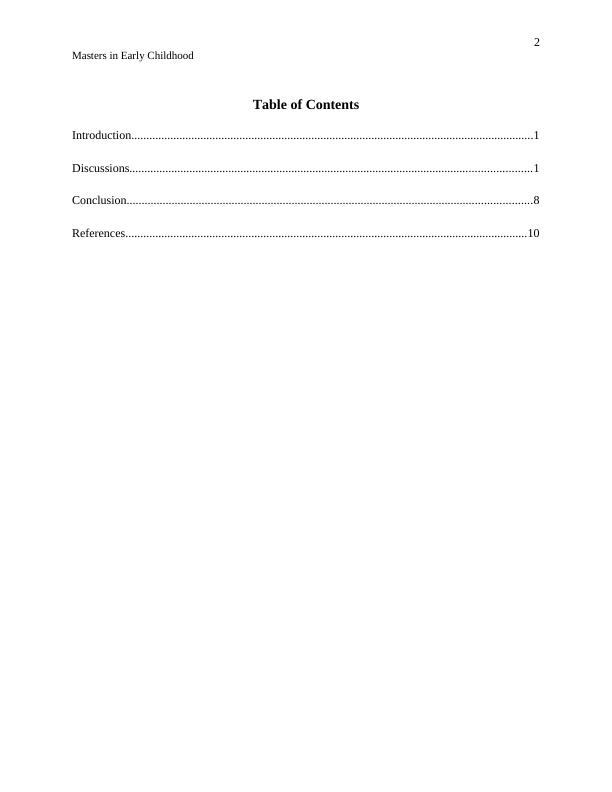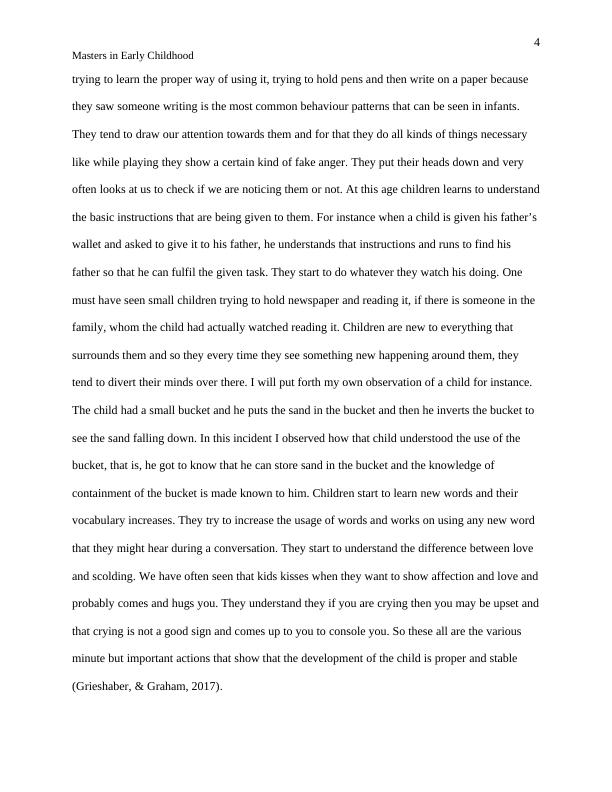Masters in Early Childhood Assessment
Added on 2022-08-22
13 Pages3974 Words19 Views
Running Head: Masters in Early Childhood
MASTERS IN EARLY CHILDHOOD
MASTERS IN EARLY CHILDHOOD

2
Masters in Early Childhood
Table of Contents
Introduction......................................................................................................................................1
Discussions......................................................................................................................................1
Conclusion.......................................................................................................................................8
References......................................................................................................................................10
Masters in Early Childhood
Table of Contents
Introduction......................................................................................................................................1
Discussions......................................................................................................................................1
Conclusion.......................................................................................................................................8
References......................................................................................................................................10

3
Masters in Early Childhood
Introduction
We generally have a habit of observing the environment around us. We tend to find out
the reason for every change that takes place around us. Similarly as an early childhood educator,
one person needs to observe every single movement of the child. Observations help us to
understand how well a child is doing in his social and cognitive skills. It becomes easy to
understand his behaviour and routines. Observations are a very important part, if you want to
understand the cycle in which a child is progressing so that you can pay attention to the areas of
concern and appreciate the child on the areas in which he is doing better. Observations help to
understand the sphere of interest of the child and how well a child responds to the transitions and
changes around him. For an early childhood educator, observing begins while noticing how a
child behaves in a particular situation, how well does he interacts with others and what are his
reactions to the dynamism around him. The behaviour pattern differs a lot when it comes to
infants and kindergarten children. The response to any stimulus in the environment will be
absorbed in different ways by children of different age groups. A child may react in a certain
way to an incident while there might be a completely different reaction from the other child
(Stirrup, Evans, & Davies, 2017).
Discussions
Play during early childhood is very crucial for the overall development of the child.
While playing a child learns to make a healthy use of its brain which improves his thinking
capacity. Children lying in the age group of 0-3 years are basically absorbing whatever they see
around them. Thus imitating the habit of elders, making weird noises, grabbing objects and
Masters in Early Childhood
Introduction
We generally have a habit of observing the environment around us. We tend to find out
the reason for every change that takes place around us. Similarly as an early childhood educator,
one person needs to observe every single movement of the child. Observations help us to
understand how well a child is doing in his social and cognitive skills. It becomes easy to
understand his behaviour and routines. Observations are a very important part, if you want to
understand the cycle in which a child is progressing so that you can pay attention to the areas of
concern and appreciate the child on the areas in which he is doing better. Observations help to
understand the sphere of interest of the child and how well a child responds to the transitions and
changes around him. For an early childhood educator, observing begins while noticing how a
child behaves in a particular situation, how well does he interacts with others and what are his
reactions to the dynamism around him. The behaviour pattern differs a lot when it comes to
infants and kindergarten children. The response to any stimulus in the environment will be
absorbed in different ways by children of different age groups. A child may react in a certain
way to an incident while there might be a completely different reaction from the other child
(Stirrup, Evans, & Davies, 2017).
Discussions
Play during early childhood is very crucial for the overall development of the child.
While playing a child learns to make a healthy use of its brain which improves his thinking
capacity. Children lying in the age group of 0-3 years are basically absorbing whatever they see
around them. Thus imitating the habit of elders, making weird noises, grabbing objects and

4
Masters in Early Childhood
trying to learn the proper way of using it, trying to hold pens and then write on a paper because
they saw someone writing is the most common behaviour patterns that can be seen in infants.
They tend to draw our attention towards them and for that they do all kinds of things necessary
like while playing they show a certain kind of fake anger. They put their heads down and very
often looks at us to check if we are noticing them or not. At this age children learns to understand
the basic instructions that are being given to them. For instance when a child is given his father’s
wallet and asked to give it to his father, he understands that instructions and runs to find his
father so that he can fulfil the given task. They start to do whatever they watch his doing. One
must have seen small children trying to hold newspaper and reading it, if there is someone in the
family, whom the child had actually watched reading it. Children are new to everything that
surrounds them and so they every time they see something new happening around them, they
tend to divert their minds over there. I will put forth my own observation of a child for instance.
The child had a small bucket and he puts the sand in the bucket and then he inverts the bucket to
see the sand falling down. In this incident I observed how that child understood the use of the
bucket, that is, he got to know that he can store sand in the bucket and the knowledge of
containment of the bucket is made known to him. Children start to learn new words and their
vocabulary increases. They try to increase the usage of words and works on using any new word
that they might hear during a conversation. They start to understand the difference between love
and scolding. We have often seen that kids kisses when they want to show affection and love and
probably comes and hugs you. They understand they if you are crying then you may be upset and
that crying is not a good sign and comes up to you to console you. So these all are the various
minute but important actions that show that the development of the child is proper and stable
(Grieshaber, & Graham, 2017).
Masters in Early Childhood
trying to learn the proper way of using it, trying to hold pens and then write on a paper because
they saw someone writing is the most common behaviour patterns that can be seen in infants.
They tend to draw our attention towards them and for that they do all kinds of things necessary
like while playing they show a certain kind of fake anger. They put their heads down and very
often looks at us to check if we are noticing them or not. At this age children learns to understand
the basic instructions that are being given to them. For instance when a child is given his father’s
wallet and asked to give it to his father, he understands that instructions and runs to find his
father so that he can fulfil the given task. They start to do whatever they watch his doing. One
must have seen small children trying to hold newspaper and reading it, if there is someone in the
family, whom the child had actually watched reading it. Children are new to everything that
surrounds them and so they every time they see something new happening around them, they
tend to divert their minds over there. I will put forth my own observation of a child for instance.
The child had a small bucket and he puts the sand in the bucket and then he inverts the bucket to
see the sand falling down. In this incident I observed how that child understood the use of the
bucket, that is, he got to know that he can store sand in the bucket and the knowledge of
containment of the bucket is made known to him. Children start to learn new words and their
vocabulary increases. They try to increase the usage of words and works on using any new word
that they might hear during a conversation. They start to understand the difference between love
and scolding. We have often seen that kids kisses when they want to show affection and love and
probably comes and hugs you. They understand they if you are crying then you may be upset and
that crying is not a good sign and comes up to you to console you. So these all are the various
minute but important actions that show that the development of the child is proper and stable
(Grieshaber, & Graham, 2017).

End of preview
Want to access all the pages? Upload your documents or become a member.
Related Documents
Observing Children Behaviour: Development of Attachment, Cognitive and Motor Skillslg...
|14
|3212
|66
Early Childhood Education and Carelg...
|31
|4020
|400
Assignment On Aggressive Behaviourlg...
|3
|701
|21
Assessment of Language Development in a 23-Month-Old Childlg...
|13
|3368
|53
Child Psychology - Critical Stage for Language Developmentlg...
|4
|782
|12
Child Observation Question Answer 2022lg...
|3
|626
|15
